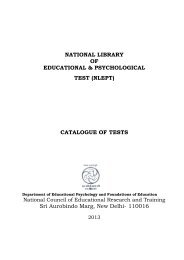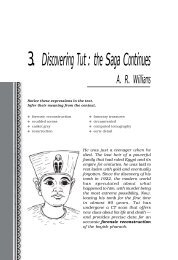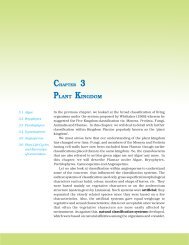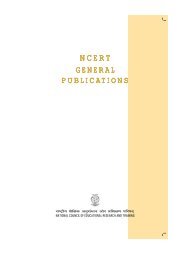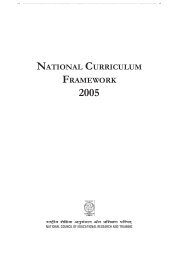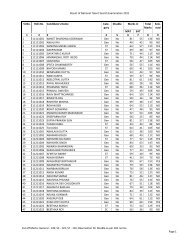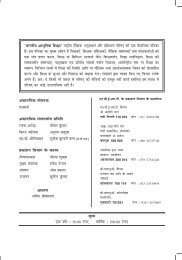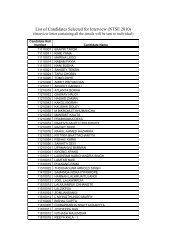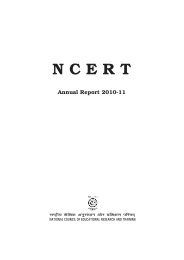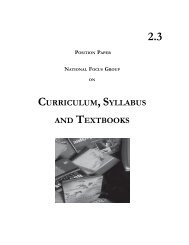indian education - National Council Of Educational Research And ...
indian education - National Council Of Educational Research And ...
indian education - National Council Of Educational Research And ...
You also want an ePaper? Increase the reach of your titles
YUMPU automatically turns print PDFs into web optimized ePapers that Google loves.
22 Journal of Indian Education August 2007<br />
report (1996) on Learning to live together<br />
as the central pillar of <strong>education</strong> is the<br />
indication that <strong>education</strong> must be geared<br />
to promote a culture of peace, tolerance,<br />
democratic values, human rights and<br />
duties among students. The <strong>National</strong><br />
Curriculum Framework – 2005, strongly<br />
advocates <strong>education</strong> for peace at all<br />
levels of schools.<br />
Peace, however is an elusive concept<br />
having different interpretations in<br />
different cultures as well as different<br />
connotations for the spheres in which<br />
peaceful processes are applied. It ranges<br />
from inner pace to outer peace.<br />
Consequently, the interpretation of<br />
peace ranges from absence of war, and<br />
society without structural violence to<br />
liberation from exploitation and injustice<br />
of any kind, ecological balance and<br />
conservation and peace of mind, etc.<br />
Education for pace therefore includes a<br />
variety of issues like human rights<br />
<strong>education</strong>, environmental <strong>education</strong>,<br />
international <strong>education</strong>, conflict<br />
resolution <strong>education</strong> and development<br />
<strong>education</strong>, etc.<br />
A review of programmes on <strong>education</strong><br />
for peace in different countries indicates<br />
that they differ considerably in terms of<br />
ideology, objectives, emphasis, curricula,<br />
content and practices, etc. for instance,<br />
in Australia, <strong>education</strong> for peace focuses<br />
on challenging ethnocentrism, cultural<br />
chauvinism and violence and promoting<br />
cultural diversity, nuclear disarmament,<br />
and conflict resolution (Burns, 1985,<br />
Lawson and Hutchinson, 1992). While<br />
in Japan it targets issues of nuclear<br />
disarmament, militarism and the nature<br />
of responsibility for acts of violence<br />
performed in the past (Murakami, 1992).<br />
In South America, <strong>education</strong> for peace<br />
addresses structural violence, human<br />
rights and economic inequality (Garcia,<br />
1984; Rivera, 1978) and in the United<br />
States, it is often concerned with<br />
prejudice, violence and environmental<br />
issues (Harris, 1996, Stomfay-Satitz,<br />
1993).<br />
In India <strong>education</strong> for peace<br />
programmes have traditionally been<br />
concerned with promoting certain core<br />
values. Mahatma Gandhi envisaged a<br />
non-violent society, which would be free<br />
from exploitation of any kind, and can<br />
be achieved through the instrument of<br />
<strong>education</strong>. In Gandhian concept of peacetruth,<br />
non-violence, self-suffering and<br />
means and end relationships are<br />
important. The <strong>education</strong>al policies of the<br />
country lay stress on combative role of<br />
<strong>education</strong> in eliminating obscurantism,<br />
religious fanaticism, violence,<br />
superstition and fatalism, and<br />
promote some core values such as<br />
India’s common cultural heritage,<br />
egalitarianism, democracy, secularism,<br />
equality of sexes, observance of small<br />
family norms and inculcation of scientific<br />
temper, etc. Peace and living together<br />
have been integral part of Indian way of<br />
living and manifested in its Constitution<br />
through various articles. It firmly believes<br />
that inculcation of certain values among<br />
younger generation would help them to<br />
exist in the dynamic socio-cultural fabric<br />
with peace, harmony and prosperity.<br />
This is the reason why all commissions<br />
and committees on <strong>education</strong> in India,<br />
like, the Radha Krishnan Commission<br />
(1948-49), Mudaliar Commission<br />
(1952-53), Sri Prakash Commission<br />
(1959), Kothari Commission (1964-66),<br />
Sampurnanad Commission (1961),<br />
Rammurti Committee (1992) and Chavan



